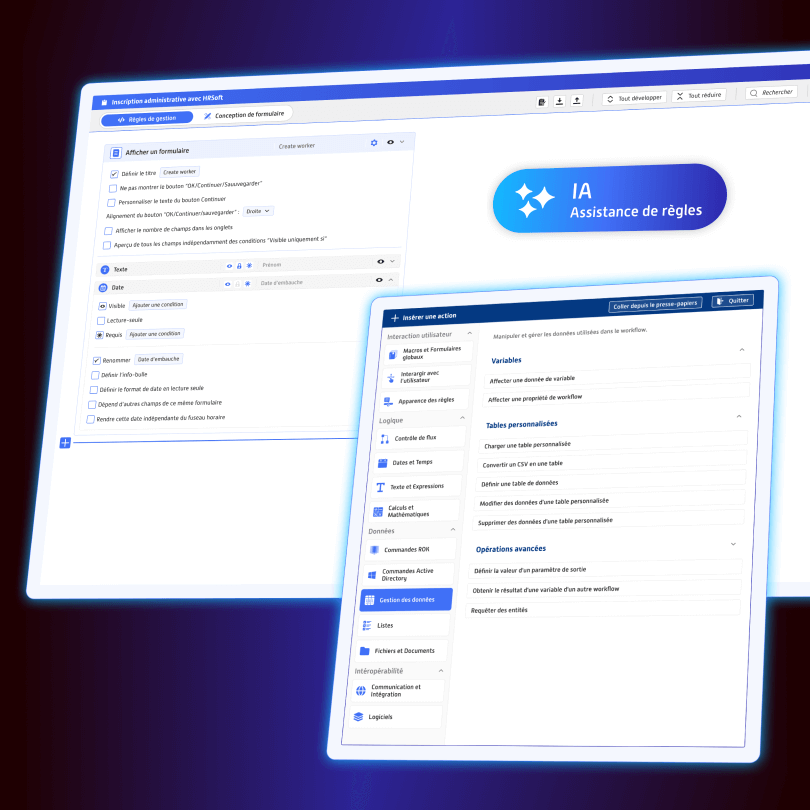In the era of the digital enterprise, the ability to instantly visualize its internal and external organizational structure through accurate, editable, and real-time maintained charts is fundamental. This requirement aims to place the individual at the heart of the information system, with the goals of clearly identifying roles and responsibilities, allocating necessary digital resources, and optimizing business processes while securing the organization and its information system.
To date, no platform integrates in a single offering the real-time integration of organizational charts and authorization charts, the integration of workflow tools needed to manage employee flows, or iBPMs to work on optimizing existing processes in dynamic environments with shifting organizations.
Even so, some solutions specialized in human resources management (HRIS) or identity and access management (IAM) partially meet these needs (often in conjunction with other tools) (1), the challenge of maintaining this information up-to-date in real time remains significant. According to Gartner, 75% of companies cannot provide a real-time mapping of permissions. It is also rare to see charts that dynamically integrate both vertical and transversal hierarchical dimensions, both endogenous and exogenous.
In this context, ROK stands out as an innovative platform that has developed a unique concept of integrated position modeling in NoCode, allowing for the merger of organizational roles (HRIS) and permissions (IAM). This approach greatly simplifies the maintenance of real-time data integrity with various directories and tools already in place. Organization: Modeling & Monitoring of Flows with Who’s Who (rok-solution.com)
ROK can be positioned upfront to manage employee movements through efficient onboarding flows (modeled in NoCode) and dispatch information in real time to the HRIS, existing ITSM directories, or IAM in place. Depending on company policies, ROK can also be used as a central hub consolidating various digital entries, bridging gaps and offering a simple orchestration interface. Onboarding, management of assets and application rights (rok-solution.com).
The platform, mainly available as SaaS at about €5 per user, can also be offered as an on-premise solution depending on specific needs. ROK offers a responsive web interface and can be deployed (in multi-tenant and multi-instance) on any type of cloud, public or private.
Mr. Pierre Boulet, CEO of Novares Group (an automotive supplier that employs 10,000 people across more than 20 countries, 37 production sites, 7 technical centers, and 6 centers of expertise) testifies:
“Managing an international group requires daily management of a diversity of cultures and backgrounds. When making acquisitions, it is crucial to integrate different cultures into the most harmonious whole possible. The HR challenge is daily. Implementing ROK is a formality in these processes that allow our employees to position themselves in the organization both at their level and that of their colleagues, which is crucial in a group structure.
Today ROK is considered our cornerstone, it is an HR database therefore everything we do is based on it. It meets the need and is fully embedded in our business processes. For example, all the company’s workflows (IN – OUT – MOVE) are managed from ROK, and the visualization part is very used.
The solution also allows us to manage the allocation of assets, standardize hiring circuits, and manage delegation of authority, thus eliminating many frustrations among our employees. This solution, deployed in all countries to a very diverse population because its interface is accessible with simple training, has ended up being adopted by HR, even the most reluctant ones.”
Novares: Organizational management at the heart of the automotive industry (rok-solution.com)
ROK thus positions itself as an original and comprehensive response to the challenges of organizational management and information security for contemporary businesses, marking a significant evolution in how companies can orchestrate their application rights and organizational structure dynamically with minimal effort and cost.
(1) Workday HCM, Microsoft 365 HR, Oracle HCM, SAP SuccessFactors combined with SAP Cloud IAM… for the most complete solutions, however, they are rarely simple to implement and often require additional modules or third-party integrations.
ROK Decoder: Your Questions, Our Answers!
The Who’s Who has never been so clear.
What does 'Who’s Who' mean?
The who’s who, as seen by ROK, is a graphical representation that allows you to visualize through multiple charts who is who and also who does what, with which tools (Document Management Systems and Applications) and what risks are involved.
This visual directory is integrated in real-time with your Active Directory (AD), your HR Information System (HRIS), Identity and Access Management (IAM), etc.
It manages and allows you to visualize both hierarchical and lateral links and can be printed. It is multi-company and also allows you to integrate your ecosystem of partners (subcontractors, temporary workers, consultants). It is dynamically maintained in real-time and can interface with your application ecosystem to provision and maintain up-to-date authorizations.
In the same vein, it allows you to edit job descriptions or manage your Outlook mailing lists (or other email systems) in real-time.
It is a true 360-degree control tower of your organization.
How do we ensure that the charts are up-to-date in real-time?
ROK incorporates a No Code module that allows you to propose onboarding, moving, and outboarding flows close to your specific needs and also to connect with your application ecosystem via web services (AI-assisted modeling).
You can choose to see ROK as the hub for employee movements and let it automatically update your HRIS, IT Service Management (ITSM), IAM, or use it as a hub collecting information from these various sources (often multiplied in groups) to orchestrate them; in the latter case, you would complement (unaccounted ecosystems or orphan subsidiary applications) the untreated information by quickly and easily creating the necessary collection apps through the No Code module.
How do we visualize, print, and understand complex and numerous organizations?
The charts in ROK are multi-indexed; you can thus view them according to the axis of interest at any given moment by presenting them by: company, site, department, function, business unit, product line, market, etc.
You can also visualize both hierarchical and lateral links…
You can define your graphic charter and colors and concatenate your positions by group or type of function so that a sprawling diagram can fit on a printable A4 page.
Why does a platform offer both chart modeling and a NoCode app creation lab?
Our architecture is unique in the application world and designed to manage who is who and who does what. The flows created in no code rely on charts and not individuals, even if they are grouped under notions of role.
ROK’s philosophy is to place the individual at the heart of the IT system, not as a byproduct of activity.
A huge advantage is that we can thus guarantee instantaneous updates as soon as an organizational movement occurs (man, process, or norm).
This model allows us to ensure among other things that any app created will be secure in terms of access (ROK is used by some of our clients to update their workflows or apps in real-time and automatically).
I often hear about 'role' (in both IT and HR contexts); what does it mean?
There are two definitions of a role depending on whether we are talking about organization (organizational charts) or IT rights (Identity and Access Management, IAM / Identity Governance and Administration, IGA).
In organizational terms (organizational charts), a role refers to a set of responsibilities, tasks, and objectives assigned to a person or a group within the organization. The aim is to facilitate the achievement of the organization’s objectives, organize work, and clarify responsibilities and expectations. The concept of role in this context is limited to defining the tasks, responsibilities, and skills required to perform the work.
In terms of identity and access management (IAM), a role is an abstraction that groups a set of permissions and access rights to IT resources, thus simplifying the management of rights and access for users and systems. The goal is to ensure that individuals have access to the IT resources they need for their work, while limiting access to unnecessary or sensitive information to maintain information security. The notion of role in IT is limited to managing access rights to systems, applications, and data, based on professional needs and security policies.
The former is managed by HR Information Systems (HRIS), and the latter by IAM, sometimes by the directory.
The distinction between these two concepts is crucial as it reflects the difference between managing people and processes in an organization (organizational roles) and the technical management of access to systems and data (IAM role). For example, to clarify, the organizational chart from the HRIS is not the same as one from IAM tools (for the few solutions that allow editing of an organizational chart, which are rare).
As a result, the business side and IT side do not always understand each other. Similarly, IT roles as defined for the use of ERP (a set of permissions) will not be the same as those defined for CRM. Consequently, the same employee will have as many roles at the IAM level as there are applications used, while in an organizational context, they will have only one role.
HR generally leads in informing of organizational movements from which one seeks matrices of rights attribution that serve the IT director to configure each assigned application.
As for the rights assignable to the partner ecosystem who are not employees and thus not directly managed by the HRIS, it is somewhat each to their own.
This explains why managing organizational charts and application rights in real-time is a real challenge and why very few IT directors can produce a comprehensive real-time application map.
How do we reconcile these different notions of role depending on whether we are talking about IT or HR?
The unique feature of ROK globally revolves around the concept of POSITION in ROK, which allows concatenating/fusing the two approaches (organizational role and IT role) into a single object. To do this, we manage on the same platform both the who’s who and the no-code, and we pilot access rights to IT (but also to Document Management Systems, Separation of Duties, etc.) through tasks, resulting in an extremely effective IAM.
This organic and systemic approach to ROK’s data model makes it a unique platform that can dynamically guarantee the integrity of application rights with an always up-to-date organizational chart.
What we can do with ROK, to our knowledge, no other platform can do, and the benefits are immediately measurable in terms of security, visibility, and simplicity.
Is ROK suitable for all sizes of companies?
ROK is a multi-tenant and multi-instance cloud solution; this allows us to dynamically scale the size of the database and the number of necessary virtual machines in real-time.
The SaaS user cost is approximately €5, decreasing with volume, and includes the No Code module.


